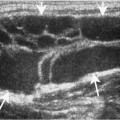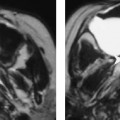Chapter 65 Laryngeal carcinoma is the most common head cancer and accounts for about 2% of all carcinomas. The false vocal cord (FVC) are a subsite of the supraglottic larynx. However, this is an unusual primary site for a supraglottic carcinoma. The major risk factors are tobacco and alcohol. Other reported findings are occupational exposure to oil, grease, and cement dust. Supraglottic carcinoma is more common in men (5–10:1) and usually presents between the ages of 50 and 80. The staging of supraglottic carcinoma are presented in Table 65–1. Patients usually present with hoarseness. Patients with advanced lesions may present with difficulty breathing and weight loss. FVC tumors may extend inferiorly to involve the true vocal cords. Such submucosal spread is often clinically occult and may lead to understaging of the lesion if this extension is undetected prior to surgery. FVC tumors may extend laterally to involve the medial wall of the pyriform sinus and medially to the inferior portion of the epiglottis, thereby, increasing the likelihood of invasion of the preepiglottic space. Cartilage invasion by FVC carcinoma is less common when compared to glottic carcinoma, and when present is typically seen with advanced lesions.
Squamous Cell Carcinoma of the False Vocal Cord
Epidemiology
Clinical Findings
Pathology
Stay updated, free articles. Join our Telegram channel

Full access? Get Clinical Tree








